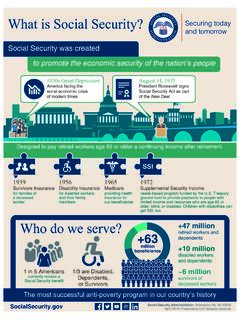Transcription of THE BENEFITS OF FARM TO SCHOOL
1 THE BENEFITS OF farm TO SCHOOLB enefits of farm to SchoolStay InformedJoin our network: @FarmtoSchoolFacebook National farm to SCHOOL NetworkInstagram @FarmtoSchoolGROWING STRONGER TOGETHERN ational farm to SCHOOL Network is as an information, advocacy and networking hub for communities working to bring local food sourcing, SCHOOL gardens and food and agriculture education into SCHOOL and early care and education DevelopmentPublicHealthEducationEnvironm entEquity & Community EngagementWhat is farm to SCHOOL ? farm to SCHOOL enriches the connection communities have with fresh, healthy food and local food producers by enhancing food purchasing and education practices at schools and early care and education sites. farm to SCHOOL , inclusive of farm to early care and education, empowers children and their families to make informed food choices while strengthening the local economy and contributing to vibrant communities.
2 farm to SCHOOL implementation differs by location but always includes one or more of the following three core elements:Procurement: Local foods are purchased, promoted and served in the cafeteria or at meal times, as a snack or in classroom : Students participate in education activities related to agriculture, food, health and nutrition. SCHOOL gardens: Students engage in hands-on, experiential learning through gardening. KIDS WINFarm to SCHOOL provides all kids access to nutritious, high-quality, local food so they are ready to learn and grow. farm to SCHOOL activities enhance classroom education through hands-on learning related to food, health, agriculture and nutrition. FARMERS WINFarm to SCHOOL can serve as a significant financial opportunity for farmers, fishers, ranchers, food processors and food manufacturers by opening doors to an institutional market worth billions of WINFarm to SCHOOL BENEFITS everyone from students, teachers and administrators to parents and farmers, providing opportunities to build family and community engagement.
3 Buying from local producers and processors creates new jobs and strengthens the local farm to SCHOOL ? Updated May 2020 economic Development Job Creation and economic Activity Creation and maintenance of jobs in the community and in the state: Case study models demonstrate for every job created by SCHOOL districts purchasing local foods, additional economic activity creates another jobs in the economic impact 4 Increase in economic activity in the local community and in the 7 Each dollar invested in farm to SCHOOL stimulates an additional $ $ of local economic activity, in one case resulting in $ million overall contribution to the ,2,4 Strengthen connections within the state s food Increase in money kept in the local economy, as farm to SCHOOL producers purchase more inputs ,5,7 SCHOOL and District economic BENEFITS Increase in student and teacher meal participation from percent to 16 percent (average +9 percent)
4 , generating increased revenue for schools through meal ,8 11 Decrease in SCHOOL meal program costs by utilizing SCHOOL or district grown Producer and Food System Impacts Increase in income from farm to SCHOOL sales and establishment of a long-term revenue stream for individual ,10,13 Increase in number of vendor and producer relationships and diversity of methods of procurement used by Increase in market diversification and economic growth opportunities for farmers, including forward contracting, and exploration of processing and value-added product creation for institutional ,2,10,14,15 Increase in social capital and positive relationships for farmers with SCHOOL districts, families and community ,10,12,16,17 Public HealthStudent Food and Nutrition Knowledge, Attitudes and Behaviors Improvement in early childhood and K-12 student health behaviors, including: choosing healthier options at SCHOOL meals;10,13,18 22 consuming more and a greater variety of fruits and vegetables through farm to SCHOOL meals and at home (+ to + servings/day);10,19 21,23 31,31 39 decrease in preference for and consumption of less healthy foods and sodas;18,34,37 and increasing physical ,30 Demonstrated willingness to try new foods and healthier op-tions (in early childhood and K-12 age groups).
5 20,22 24,28,34,35,39 43 Increased preference for fruits and ,30,33,34,38,40 Improved knowledge and attitudes regarding food literacy, nutrition, health behaviors, and fruit and vegetable ,18 23,27,38,41,43 45 Increase in fruit and vegetable consumption among those with the lowest previous Increase in fruit and vegetable intake associated with all core elements of farm to SCHOOL . When schools offer SCHOOL gardens, percent of students eat more fruits and vegetables;29 When schools serve local food, percent of students eat more fruits and vegetables;29 and When students participate in hands-on, food-based activities, students triple amount of fruit and vegetable Long-term impact on health behaviors: Increase in willingness to try and increased consumption of fruits and vegetables at college age due to gardening exposure at a young Potential to minimize diet-related diseases in childhood, such as obesity and diabetes, through the promotion of eating fresh fruits and vegetables, specifically for high-risk, low-income ,28 Healthier SCHOOL and Early Care and Education Food Environments Support in achieving and adhering to wellness policies in early care and education setting and K-12 ,48 50 Improvement in food service operations to support healthy outcomes, such as increased cafeteria offerings of fruits and ,41,46.
6 51 Higher nutrient content in meals offered and foods consumed in early care Family and Community Food and Nutrition Behaviors and Access Increase in access to fruits and ,53 55 Increase in planning and preparing meals at Increase in ability and interest in incorporating healthier foods into family diets and guiding children in early childhood and K-12 to make healthier ,43,52 Positive changes in shopping patterns reflecting healthy and local foods, including knowledge of where to purchase local ,34,43,54 Increase among young children in asking their families to make healthier ,43,56 Improvement in household food security and food ,12,53,54,57 National farm to SCHOOL Network 2 National farm to SCHOOL Network 3 EducationStudent Engagement and Whole Child Development Increase in SCHOOL engagement and positive attitudes about SCHOOL and ,30,37,58 60 Provides children with opportunities for social and emotional growth; improves life skills, self-esteem and sense of self, social skills and ,32,34,42,45,58,59,61,62 Greater opportunity for necessary experiential and hands-on 64 Supports SCHOOL readiness in young Encourages low-income students and students of color to engage in food and environmental issues in their Academic Achievement Increase in knowledge in science and STEM concepts (in early childhood and K-12 settings).
7 11,12,30,42,61,62,65,66 Provides children with an understanding of gardening, agriculture (growing cycles, seasonality), local foods and the ,30,34,38,39,48,62,65,66 Enhanced overall academic achievement in K-12 settings, including grades and test ,32,63 Increased opportunity for innovative teaching platforms for core subjects, such as science, math and language arts in early childhood and K-12 ,34,61,62 Family, Educator and Staff Engagement Positive changes in educators diets and Positive educator and caregiver attitudes about integrating farm to SCHOOL related information in curriculum and intention to implement farm to SCHOOL activities in the ,67,68 Increase in parent acceptance of farm to SCHOOL programs as their children demonstrate healthier behaviors such as increased fruit and vegetable.
8 54 Increased parent engagement in early care and education and K-12 educational ,42,62 Improvements in food service staff motivation and morale; increase in knowledge and interest in local food preparation and seasonal recipes; increase in interactions with teachers to strengthen classroom and cafeteria Opportunity to align purchasing practices with Environment Reduced food waste of local food, both on the production side as well as plate waste; decrease in overall food waste due to farm to SCHOOL ,28,69,70 Reduced transportation-related environmental impacts, such as emissions of air ,7,28,71 Support of environmentally sound, sustainable and socially just approaches to food production, processing, packaging, transportation and ,17, 3 4 Equity and Community Engagement Influence neighboring communities to start or expand farm to SCHOOL Improved support and acceptance of healthier SCHOOL and early care and education meals among parents and the ,73 Promotes positive linkages between schools and communities.
9 Particularly in low-income communities and communities of Increased student appreciation for and knowledge of diverse cultures and customs as well as engagement of diverse families in SCHOOL Increase in opportunities to combat racial and economic inequities in the SCHOOL food Begins to reduce racial and social inequities in educational opportunities through access to experiential learning, resulting in higher student test Promotes environmental equity and links concepts of sustainability to social ,63 PopulationReachBenefitsStudentsFruit and vegetable consumption Increased + to + servings per day - Public HealthPhysical activityIncreased physical activity- Public HealthHealthMinimized risk of childhood obesity and diet-related diseases such as diabetes- Public HealthFood system awarenessIncreased knowledge about gardening, agriculture, healthy food, local food, seasonality - Public Health - Education Food choicesWillingness to try new and healthy food.
10 Choosing healthier options in the cafeteria and at home - Public Health - EducationAcademic achievementOverall improvement in both grades and test scores (K-12)- EducationSocial-Emotional Wellbeing Improved life skills, self-esteem, social skills and other types of personal growth- EducationAdvancing EquityReducing health and educational inequities among low-income communities and communities of color; leveraging community engagement in environmental issues- Public Health- Equity & Community EngagementSchoolsMeal participationAverage increase of 9% (range 3% to 16%) - economic Development- Public HealthMeal costLowers SCHOOL meal program costs- economic DevelopmentSchool food environmentIncreased offerings of fruits and vegetables; positive cafeteria atmosphere; SCHOOL wellness policy adherence - Public HealthFood service staffImproved morale; increased knowledge of local food- Education- Equity & Community EngagementEducatorsPositive diet and lifestyle changes.



